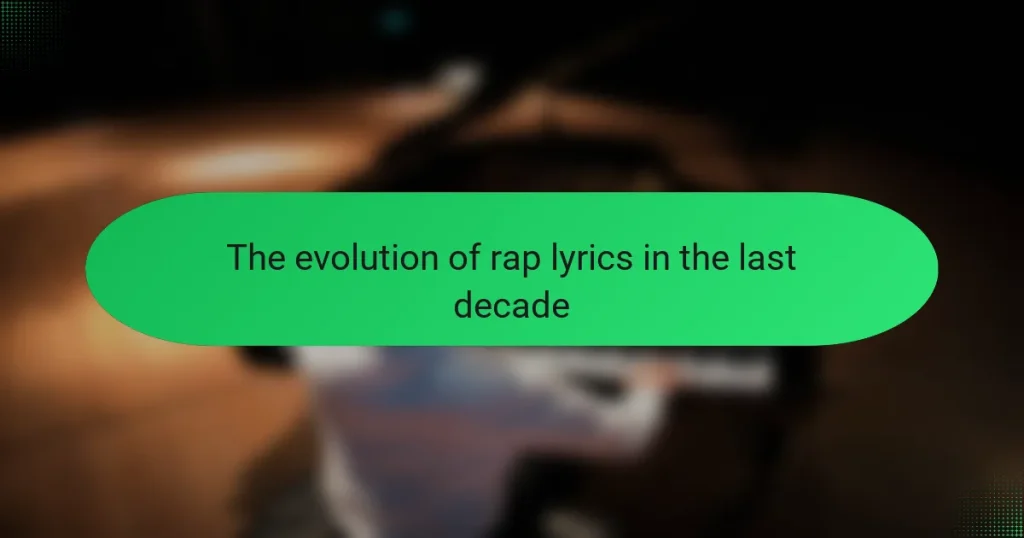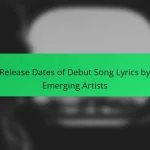The evolution of rap lyrics over the last decade reflects significant changes in themes and styles. Artists have shifted from traditional topics to more introspective and socially conscious messages, addressing issues such as mental health, identity, and systemic racism. Influences from social movements, technological advancements like streaming platforms, and cultural shifts have broadened lyrical content and diversity. Notable tracks like Kendrick Lamar’s “Alright” and J. Cole’s “Middle Child” exemplify this transformation, showcasing a blend of social commentary and personal narratives. The rise of collaborations across genres and the impact of social media have further enriched the contemporary rap landscape.
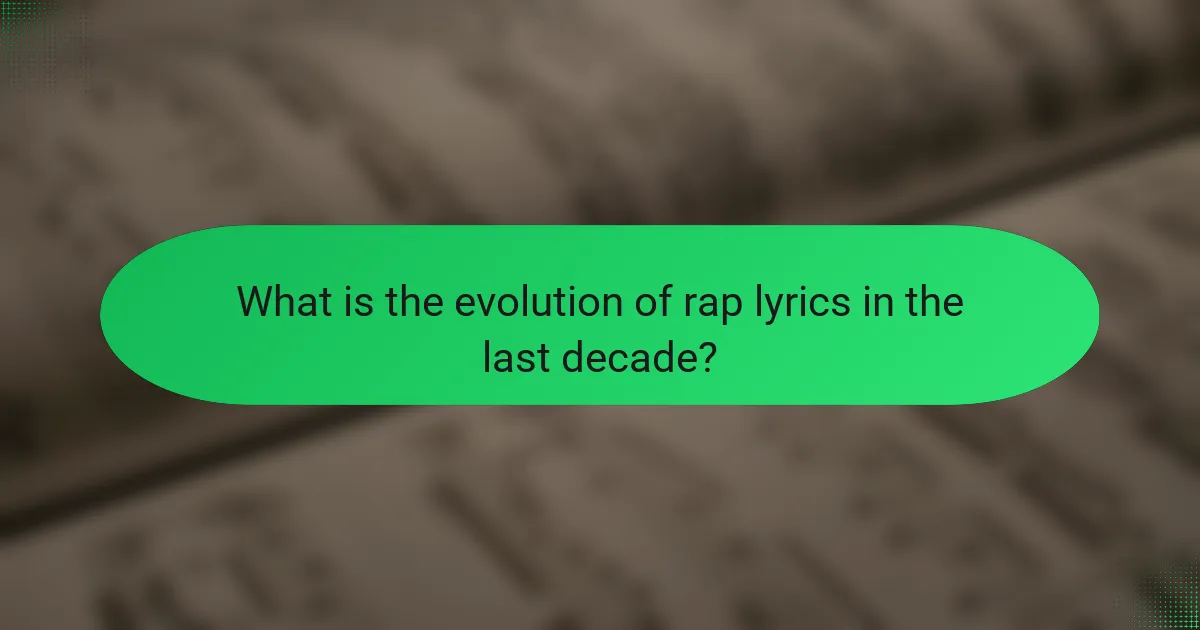
What is the evolution of rap lyrics in the last decade?
Rap lyrics have evolved significantly in the last decade. The themes have shifted from traditional topics to more introspective and socially conscious messages. Artists increasingly address mental health, identity, and systemic issues. The incorporation of diverse influences has broadened lyrical styles. Collaborations across genres have also enriched the lyrical landscape. Notable examples include Kendrick Lamar’s “DAMN.” and J. Cole’s “KOD,” which explore complex narratives. The rise of streaming platforms has democratized access, allowing independent voices to flourish. This evolution reflects broader societal changes and the genre’s adaptability.
How have rap lyrics changed in themes and styles over the past ten years?
Rap lyrics have evolved significantly in themes and styles over the past ten years. The focus has shifted from materialism and bravado to more introspective and socially conscious topics. Artists now frequently address issues like mental health, racial inequality, and personal struggles. For instance, songs like “1-800-273-8255” by Logic highlight suicide prevention, showcasing the genre’s growing awareness of mental health. Additionally, the rise of melodic flows and trap beats has transformed the musical style of rap. This shift is exemplified by artists like Lil Nas X and Juice WRLD, who blend singing with rapping. Overall, the evolution reflects a broader cultural shift towards authenticity and vulnerability in hip-hop.
What are the key themes that have emerged in rap lyrics during this period?
Key themes that have emerged in rap lyrics during this period include social justice, mental health, and personal struggles. Social justice themes address issues like racial inequality and police brutality. Artists like Kendrick Lamar and J. Cole have highlighted these topics in their work. Mental health discussions have gained prominence, with rappers openly sharing their battles with anxiety and depression. This shift reflects a broader cultural acceptance of mental health issues. Personal struggles often encompass themes of poverty and resilience. Many artists narrate their journeys from hardship to success, showcasing their determination. Additionally, themes of identity and self-empowerment have become prevalent. Rappers increasingly explore their cultural backgrounds and personal narratives.
How have lyrical styles evolved in response to cultural shifts?
Lyrical styles in rap have evolved significantly in response to cultural shifts. The rise of social media has changed how artists engage with their audience. Artists now reflect current events and social issues in their lyrics. For example, the Black Lives Matter movement has influenced many artists to address systemic racism. Additionally, the increased visibility of mental health discussions has led to more introspective themes in lyrics. The incorporation of diverse musical influences has also expanded lyrical styles. Collaborations across genres have introduced new vocabulary and storytelling techniques. Overall, these cultural shifts have prompted a more varied and socially conscious approach to rap lyrics.
Why is the evolution of rap lyrics significant in the music industry?
The evolution of rap lyrics is significant in the music industry because it reflects cultural shifts and societal issues. Over the last decade, rap has transformed from party-centric themes to complex narratives about identity, politics, and social justice. This change has attracted a broader audience and increased the genre’s influence. For example, artists like Kendrick Lamar and J. Cole address systemic racism and personal struggles in their lyrics. Their work has garnered critical acclaim and commercial success, showcasing the genre’s depth. The evolution also impacts other music genres, prompting collaborations and cross-genre experimentation. Overall, the changing nature of rap lyrics highlights its role as a powerful medium for expression and commentary.
What impact has this evolution had on mainstream music?
The evolution of rap lyrics in the last decade has significantly influenced mainstream music. This evolution has led to a greater emphasis on storytelling and personal experiences in lyrics. Artists now often address social issues, mental health, and identity. These themes resonate with a wider audience, broadening the genre’s appeal. Collaborations between rap artists and musicians from other genres have increased. This blending of styles has created new sounds and reached diverse fan bases. The rise of streaming platforms has also amplified the impact of rap. Data shows that rap is one of the most consumed genres globally. As a result, mainstream music has become more inclusive of various lyrical styles and messages.
How have audiences responded to changes in rap lyrics?
Audiences have responded to changes in rap lyrics with a mix of acceptance and criticism. Many listeners appreciate the shift towards more personal and introspective themes. This change reflects broader societal conversations about mental health and identity. Some fans celebrate the diversity of styles and messages in contemporary rap. However, others express nostalgia for traditional lyrical content focused on street narratives and bravado. The rise of platforms like social media amplifies audience reactions, allowing for immediate feedback. Data from surveys indicate that younger listeners tend to favor innovative and experimental lyrics. In contrast, older fans often prefer classic rap themes. This generational divide highlights the evolving nature of audience preferences in the rap genre.
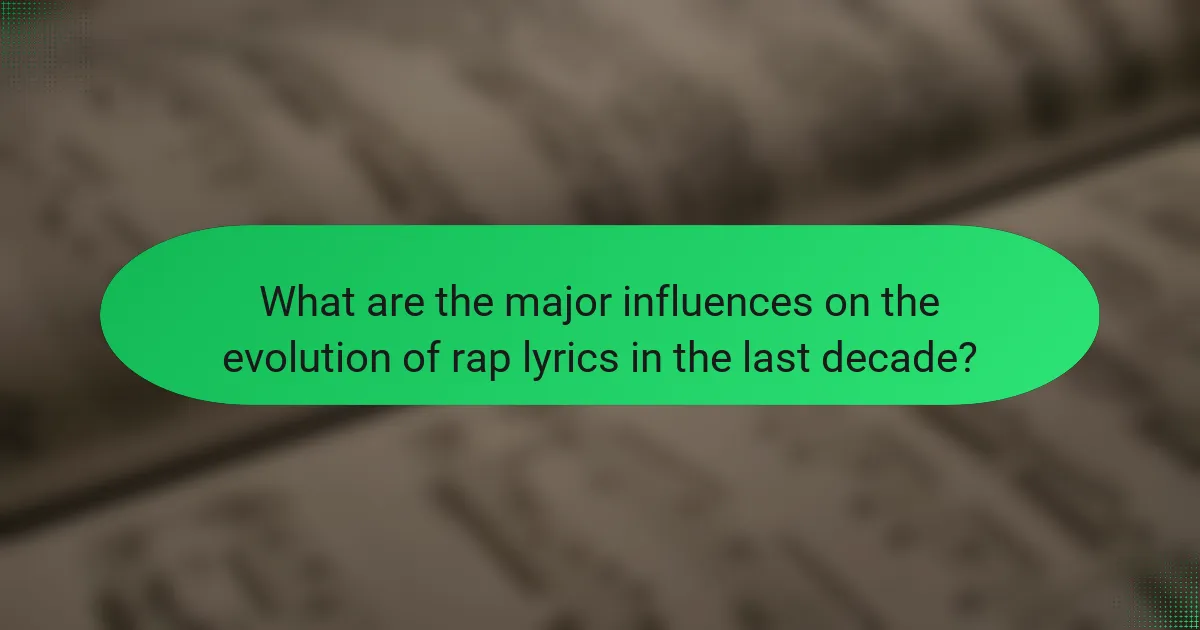
What are the major influences on the evolution of rap lyrics in the last decade?
The major influences on the evolution of rap lyrics in the last decade include social movements, technological advancements, and cultural shifts. Social movements such as Black Lives Matter have prompted artists to address systemic racism and social justice in their lyrics. Technological advancements, particularly streaming platforms, have altered how music is consumed and promoted. This has led to more diverse voices and styles in rap. Cultural shifts, including the rise of mental health awareness, have encouraged artists to explore personal struggles and vulnerabilities in their lyrics. Collaborations across genres have also expanded lyrical themes and styles. The impact of social media has enabled artists to engage directly with their audience, influencing lyrical content. These factors collectively shape the contemporary landscape of rap music.
How have social and political issues shaped rap lyrics?
Social and political issues have significantly shaped rap lyrics by influencing themes and narratives. Artists often address systemic racism, police brutality, and social inequality in their songs. For example, tracks like “Alright” by Kendrick Lamar reflect the Black Lives Matter movement. Similarly, Public Enemy’s “Fight the Power” critiques racial oppression. These lyrics resonate with listeners by articulating shared experiences and frustrations. Additionally, rap serves as a platform for activism, with artists using their voices to inspire change. The incorporation of these issues has made rap a powerful tool for social commentary and cultural expression.
What specific events or movements have influenced lyrical content?
Significant events and movements have profoundly influenced lyrical content in rap music. The Black Lives Matter movement has sparked discussions on racial injustice. This has led to lyrics addressing systemic racism and police brutality. The Me Too movement has encouraged themes of gender equality and [censured] empowerment. Additionally, the COVID-19 pandemic has inspired reflections on isolation and mental health in lyrics. The rise of social media has also changed how artists engage with their audience. Artists now incorporate real-time societal issues into their music. These influences reflect the evolving landscape of rap and its connection to contemporary events.
How do artists use their lyrics to comment on current events?
Artists use their lyrics to comment on current events by addressing social, political, and cultural issues. They often reflect the sentiments of their communities through storytelling and personal experiences. For example, many rap artists have tackled issues like police brutality and systemic racism in their songs. This is evident in tracks like “Alright” by Kendrick Lamar, which became an anthem for the Black Lives Matter movement.
Moreover, artists utilize their platforms to raise awareness about global crises, such as climate change and economic inequality. Songs like “This Is America” by Childish Gambino highlight societal issues and provoke critical discussions. Lyrics often serve as a form of protest, encouraging listeners to engage with pressing matters.
The use of real-time references in lyrics helps create a sense of urgency and relevance. Many artists incorporate news headlines or trending topics, making their music a reflection of contemporary society. This approach not only informs listeners but also fosters a collective response to current events.
What role does technology play in the evolution of rap lyrics?
Technology significantly influences the evolution of rap lyrics. Digital platforms allow artists to share their work instantly. This accessibility broadens the audience for diverse lyrical styles. Software for music production enhances the complexity of beats and sounds. Artists can manipulate their vocals and lyrics with advanced editing tools. Social media platforms enable real-time feedback and collaboration among artists. Data analytics help identify trends in listener preferences. This information shapes the direction of future lyrical content. Overall, technology fosters innovation in rap, pushing creative boundaries.
How has social media impacted the way lyrics are created and shared?
Social media has significantly transformed the creation and sharing of lyrics. Platforms like Twitter, Instagram, and TikTok enable instant feedback from fans. Artists can share snippets of lyrics directly with their audience. This immediate interaction influences lyrical content and style. Trends often emerge from viral challenges or popular hashtags. Collaborations between artists can occur more fluidly through social media connections. The accessibility of these platforms democratizes the music creation process. Independent artists gain visibility without traditional gatekeepers. Data from the Recording Industry Association of America shows a rise in streaming, driven by social media engagement.
What are the effects of streaming platforms on lyrical content and accessibility?
Streaming platforms significantly influence lyrical content and accessibility in rap music. They allow artists to reach a global audience instantly. This broad access encourages diverse lyrical themes and experimentation. Artists can share songs without traditional gatekeepers. The data from platforms informs creators about listener preferences. This feedback loop can shape future lyrical directions. Additionally, streaming platforms provide lyrics for many songs, enhancing accessibility. This feature aids in understanding complex lyrics and cultural references. Overall, streaming platforms democratize music consumption and influence lyrical creativity.
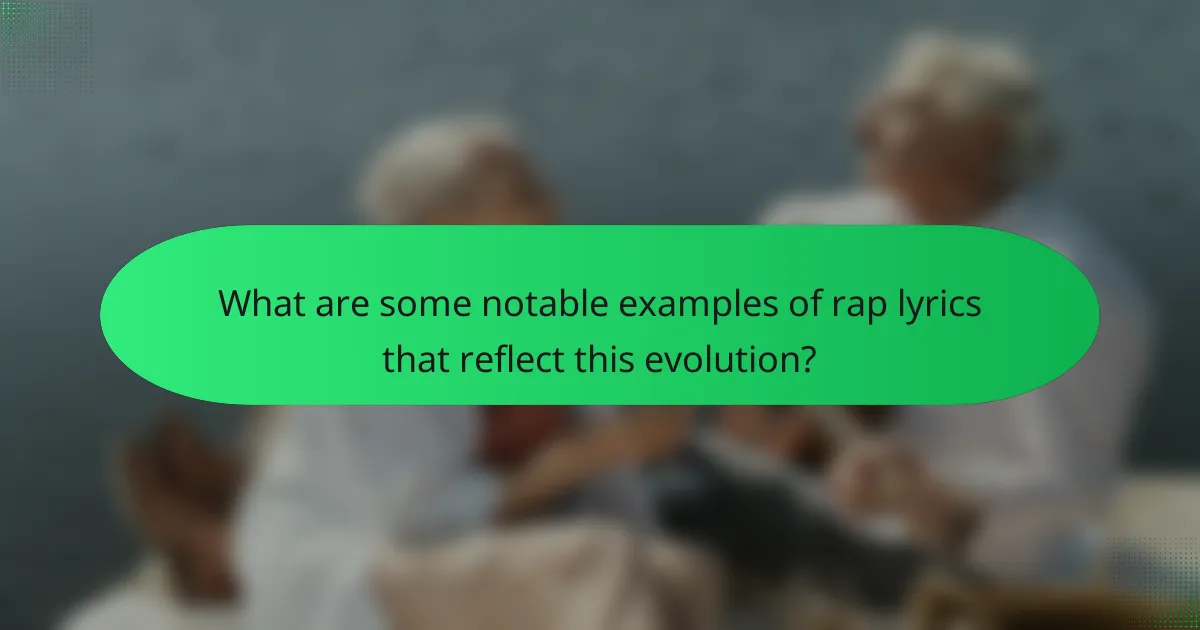
What are some notable examples of rap lyrics that reflect this evolution?
Notable examples of rap lyrics that reflect this evolution include Kendrick Lamar’s “Alright.” This song addresses social justice and resilience. It became an anthem during protests against police brutality. Another example is J. Cole’s “Middle Child.” This track discusses generational divides and personal growth within the industry. Drake’s “God’s Plan” highlights themes of generosity and community support. Additionally, Lil Nas X’s “Old Town Road” blends genres and challenges traditional norms in rap. These lyrics showcase a shift toward introspection, social commentary, and genre fusion in contemporary rap.
Which artists have significantly contributed to the evolution of rap lyrics?
Kendrick Lamar, Nas, and J. Cole have significantly contributed to the evolution of rap lyrics. Kendrick Lamar’s album “To Pimp a Butterfly” introduced complex themes of race, identity, and resilience. His lyrical depth has influenced many contemporary artists. Nas is known for his storytelling ability and social commentary, particularly in “Illmatic,” which set a standard for lyrical excellence. J. Cole’s introspective style and focus on personal experiences resonate with a wide audience. His works often explore mental health and societal issues, pushing the boundaries of traditional rap lyrics. These artists have collectively shaped the narrative and thematic complexity of rap in recent years.
How do the lyrics of these artists differ from their predecessors?
The lyrics of contemporary rap artists differ significantly from their predecessors by focusing on personal experiences and social issues. Modern artists often explore themes like mental health, identity, and systemic inequality. This shift reflects a broader cultural conversation about vulnerability and authenticity. In contrast, earlier rap often emphasized bravado, materialism, and party culture. For instance, artists like Kendrick Lamar and J. Cole address personal struggles and societal challenges in their work. This evolution is evident in tracks such as “Alright” and “Middle Child,” which tackle pressing social issues. The lyrical complexity has also increased, with intricate wordplay and storytelling techniques. Overall, these changes highlight a more introspective and socially aware approach in contemporary rap lyrics.
What are some standout tracks that exemplify this evolution?
Standout tracks that exemplify the evolution of rap lyrics in the last decade include “Alright” by Kendrick Lamar. This track addresses systemic racism and social justice, showcasing lyrical depth and narrative storytelling. Another significant track is “Sicko Mode” by Travis Scott. It features multiple beat switches and innovative structures, reflecting a shift in production and lyrical complexity. “Bodak Yellow” by Cardi B highlights the rise of female empowerment in rap, with assertive lyrics and a catchy hook. Additionally, “The Box” by Roddy Ricch demonstrates the use of melody and rhythm in rap, blending genres and appealing to a broader audience. These tracks collectively illustrate the diverse themes and stylistic advancements in contemporary rap lyrics.
How can listeners engage with and analyze the evolution of rap lyrics?
Listeners can engage with and analyze the evolution of rap lyrics by exploring lyrical themes, wordplay, and cultural references. They can compare lyrics across different eras to identify shifts in style and substance. Analyzing the context of songs, including historical and social influences, enhances understanding. Tools like lyric analysis websites and academic articles provide deeper insights. Engaging with fan discussions on platforms like forums or social media can reveal diverse interpretations. Additionally, attending live performances allows listeners to experience the evolution firsthand. Studies show that lyrical complexity has increased over the last decade, reflecting broader societal changes.
What are some effective methods for interpreting changes in rap lyrics?
Analyzing changes in rap lyrics can be effectively achieved through several methods. One method is lyrical analysis, which involves examining the themes, word choices, and stylistic shifts over time. This method reveals how artists express social issues or personal experiences differently.
Another method is historical context evaluation. Understanding the socio-political landscape during the release of specific songs provides insight into their meaning. For instance, lyrics reflecting social justice movements often change in response to current events.
Additionally, comparative analysis between artists or eras can highlight shifts in lyrical content. By comparing lyrics from different decades, one can observe trends in language and subject matter.
Listening to interviews and artist commentary also aids interpretation. Artists often explain their intentions and influences behind their lyrics, offering deeper understanding.
Lastly, fan and critic discussions on platforms like social media provide diverse perspectives on lyrical changes. Engaging with these discussions can enrich one’s interpretation of evolving themes in rap lyrics.
How can understanding lyrical evolution enhance the listening experience?
Understanding lyrical evolution enhances the listening experience by providing context to the themes and styles present in rap music. It allows listeners to appreciate the historical influences shaping current lyrics. For example, examining how social issues have been addressed in lyrics over time reveals deeper meanings. This understanding can lead to a more emotional connection with the music. Furthermore, recognizing the shifts in lyrical complexity and wordplay shows the artistic growth of artists. Studies indicate that listeners who engage with lyrical analysis report a higher level of enjoyment. This engagement fosters a greater appreciation for the artistry involved in songwriting.
The main entity of the article is the evolution of rap lyrics in the last decade. The article examines significant shifts in themes and styles, highlighting a transition from materialism to introspective and socially conscious messages that address mental health, identity, and systemic issues. It discusses key influences such as social movements and technological advancements, as well as notable examples and artists who have shaped contemporary rap lyrics. The article also explores audience responses, the impact of streaming platforms, and methods for analyzing these lyrical changes to enhance the listening experience.
